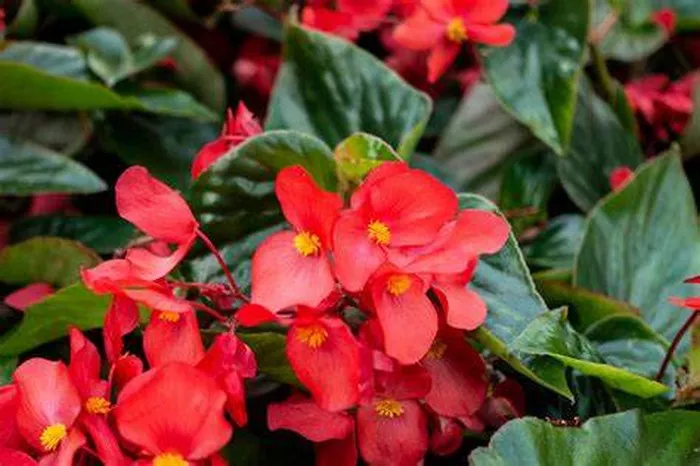Begonia flowers, with their vibrant colors and delicate petals, have long adorned gardens and landscapes. Beyond their ornamental appeal, many wonder about the culinary potential of these blossoms. Can you eat begonia flowers? In this comprehensive guide, we delve into the edibility, nutritional value, and culinary applications of begonia flowers.
Edibility of Begonia Flowers
Before incorporating begonia flowers into your culinary endeavors, it’s crucial to understand their edibility. While many species of begonias are safe to consume, some may be toxic. It’s essential to positively identify the species and verify its suitability for consumption before consumption.
Fortunately, several varieties of begonia are known to be edible, including Begonia x tuberhybrida, Begonia grandis, and Begonia semperflorens. These varieties are commonly cultivated and recognized as safe for consumption. However, it’s essential to exercise caution and avoid consuming begonias from unknown sources or those treated with pesticides or other chemicals.
To ensure safety, thoroughly wash begonia flowers before use, removing any dirt or debris. Additionally, consider sampling a small amount initially to gauge any potential adverse reactions before consuming larger quantities.
Nutritional Value of Begonia Flowers
While begonia flowers are primarily valued for their aesthetic appeal, they also offer nutritional benefits. Like many edible flowers, begonias contain various vitamins, minerals, and phytochemicals that contribute to overall health and well-being.
Begonia flowers are particularly rich in antioxidants, which help combat oxidative stress and reduce the risk of chronic diseases. These antioxidants include flavonoids, phenolic compounds, and carotenoids, which contribute to the vibrant colors of the flowers.
Furthermore, begonia flowers provide essential vitamins and minerals, including vitamin C, vitamin A, potassium, and calcium. Vitamin C supports immune function and collagen production, while vitamin A promotes eye health and supports immune function. Potassium is essential for maintaining electrolyte balance and supporting heart health, while calcium is crucial for bone strength and muscle function.
While begonia flowers may not be a significant source of macronutrients like protein and carbohydrates, their nutrient density makes them a valuable addition to a balanced diet. Incorporating begonia flowers into meals can add both visual appeal and nutritional value.
Recipes Featuring Begonia Flowers
Now that we’ve explored the edibility and nutritional value of begonia flowers, let’s delve into some creative recipes that showcase their delicate flavor and vibrant colors.
1. Begonia Flower Salad:
Ingredients:
- Fresh mixed greens (such as spinach, arugula, and lettuce)
- Assorted begonia flowers, washed and patted dry
- Cherry tomatoes, halved
- Cucumber, thinly sliced
- Red onion, thinly sliced
- Toasted nuts or seeds (such as almonds or pumpkin seeds)
Dressing:
- Extra virgin olive oil
- Balsamic vinegar
- Dijon mustard
- Honey
- Salt and pepper to taste
Instructions:
- In a large bowl, combine the mixed greens, cherry tomatoes, cucumber, and red onion.
- In a separate small bowl, whisk together the olive oil, balsamic vinegar, Dijon mustard, honey, salt, and pepper to create the dressing.
- Drizzle the dressing over the salad and toss gently to coat.
- Garnish the salad with begonia flowers and toasted nuts or seeds before serving.
2. Begonia Flower Infused Water:
Ingredients:
- Fresh begonia flowers, washed
- Filtered water
Instructions:
- Place the washed begonia flowers in a clean glass jar or pitcher.
- Fill the jar or pitcher with filtered water.
- Allow the water to infuse with the delicate flavor and aroma of the begonia flowers for at least 2-4 hours in the refrigerator.
- Serve the infused water chilled, garnished with additional begonia flowers if desired.
3. Begonia Flower Sorbet:
Ingredients:
- 2 cups fresh begonia flowers, washed and petals separated
- 1 cup water
- 1 cup granulated sugar
- Juice of 2 lemons
Instructions:
- In a small saucepan, combine the water and granulated sugar. Heat over medium heat, stirring constantly, until the sugar is completely dissolved to create a simple syrup.
- Remove the simple syrup from the heat and allow it to cool to room temperature.
- In a blender, combine the begonia petals, simple syrup, and lemon juice. Blend until smooth.
- Pour the mixture into a shallow dish or ice cream maker and freeze according to the manufacturer’s instructions until firm.
- Serve the begonia flower sorbet in chilled bowls, garnished with fresh begonia flowers for an elegant and refreshing dessert.
Conclusion
In conclusion, begonia flowers offer not only aesthetic beauty but also culinary potential. When sourced from edible varieties and prepared properly, begonia flowers can add a unique touch to salads, beverages, desserts, and more. With their delightful flavor and nutritional benefits, begonia flowers are sure to captivate both the palate and the senses. However, always exercise caution and ensure the safety of the begonia species before consumption. So, why not explore the culinary possibilities of begonia flowers and elevate your dishes with their delicate charm and subtle flavor?


